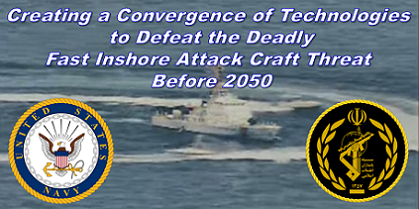[Editor’s Note: Today’s post by returning guest blogger CAPT George Galdorisi, (U.S. Navy–Ret.) was initially submitted as an entry to our recent Mad Scientist Operational Environment in 2035 Writing Contest. While addressing a key challenge facing the U.S. Navy when conducting operations in tight littoral confines against adversaries employing Fast Inshore Attack Craft (FIAC), CAPT Galdorisi’s post has cross-domain relevance, given an Operational Environment where state and non-state actors alike continue to innovate with dual use technologies to launch asymmetric attacks. With the resurgence of Jomini’s Mass, all Services must embrace new technological convergences to redress the proliferation of low cost swarming threats that threaten overmatch, regardless of domain. Read on!]
Perspective
While it is impossible to predict the nature of conflict three decades hence in 2050, one place to begin to try to narrow the possibilities is to consider history and geography. As the U.S. Secretary of Defense said in 2015, there are four nations — China, Russia, Iran and North Korea — that have had animas with the United States for some time, and the tensions with those nations have increased in recent years. Few would argue that the United States will have cordial — let alone warm — relationships with any of the four in the mid- or long-term.
Like history, geography is a factor of huge importance. For the United States, ensuring that global trade in finished products and raw materials remains unimpeded undergirds America’s continued security and prosperity. When tensions rise, it often falls to the U.S. military to guarantee that commerce on the global commons continues unabated. This requires access to littoral waterways, often in the face of a hostile threat.
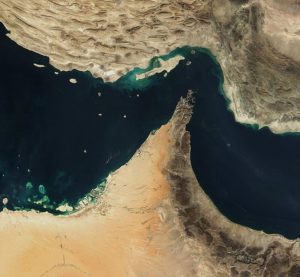
It is beyond the scope of this futures-focused paper to evaluate the threat that each of the four nations mentioned above can pose to free and open access to the world’s oceans, seas, and restricted waterways. Therefore, we will address just one nation, Iran, which sits astride the strategically vital Strait of Hormuz. In any crisis requiring U.S. and allied naval forces to enter the Arabian Gulf, these units must first transit the Strait of Hormuz. Iran has several means to threaten naval units attempting to transit this strait; however, one it has actively demonstrated is swarming attacks by Fast Inshore Attack Craft (FIAC).
Swarming FIAC Threat: A Clear and Present — and Future — Threat
The threat from multiple maneuvering fast attack craft operating in the close confines of the littoral environment has been a focus of attention for western navies for many years. Iran has been a primary cause of this concern. In the 1980s, the Iranian Revolutionary Guards Corps Navy (IRGCN) began to field weaponized Boghammar speedboats. The IRGCN’s unconventional use of these craft in the Arabian Gulf’s tanker wars of the late 1980s can, in hindsight, be seen as marking the birth of the FIAC menace in the modern era.

The asymmetric surface threat presented by swarming FIAC has taken on increased significance over the past decade, with the IRGCN still recognized as the foremost practitioner of small boat swarm tactics that combine speed, mass, coordinated maneuver, low radar signature, and concealment. Moreover, the IRGCN has continued to invest significantly in FIAC platforms and weapons, and to exercise this capability regularly in war games such as the Great Prophet IX exercise in the Arabian Gulf adjacent to the Strait of Hormuz earlier this decade. Not surprisingly, the target of this FIAC swarm attack was a simulated U.S. Navy aircraft carrier.
It is difficult to overstate the deadly threat a FIAC swarm presents to any ship, even well-armed naval vessels. This has not been lost on U.S. military and intelligence officials who have expressed concerns about this threat for many years. In a 2002 article in the U.S. Naval Institute Proceedings, a future U.S. Chief of Naval Operations and Chairman of the Joint Chiefs of Staff — then-Vice Admiral Michael Mullen — noted:
“Small, fast enemy surface combatants represent another threat to operations in geographically confined areas, where their size and the surrounding clutter of geography and traffic make long-range detection difficult…A diverse force offers promising response capabilities once enemy vessels are under way.”
In 2009, an Office of Naval Intelligence report entitled Iran’s Naval Forces — From Guerrilla Warfare to a Modern Naval Strategy articulated how the IRGCN seeks to achieve tactical success, noting that, “Modern small boats are capable of high speed, have very shallow drafts, can be difficult to detect because of their small size, and may not be positively identified even when detected, leaving them well suited for conducting hit-and-run style attacks.”

More recently, the Office of Naval Intelligence report entitled Iranian Naval Forces: A Tale of Two Navies highlighted the extent to which the IRGCN had perfected swarm attacks by FIAC craft. Most ominously, the report quoted the IRGCN Commander, Rear Admiral Ali Fadavi —
“It is natural that we always conduct training, drills, and exercises for confrontation with the operational goals we have, and the Americans and the entire world knows that one of the IRGC Navy’s operational goals is to destroy America’s Navy.”
In the face of such virulent rhetoric, it is unsurprising that U.S. Navy leaders have sought ways to deal with the compelling FIAC threat. However, the magnitude of this menace has eluded efforts to counter it using current weapons and tactics. While there are some promising breakthroughs on the mid- and far-term horizon, the Navy may be well served to look for a convergence of technologies to counter this deadly threat sooner.
Current Tactics and Technologies to Defeat Swarming FIAC
The increasing attention paid to the swarming FIAC threat in recent years has been accompanied by the development of weapon systems — particularly, ship borne gun systems and air- and surface-launched precision guided weapons — optimized for defensive anti-surface warfare (ASuW).
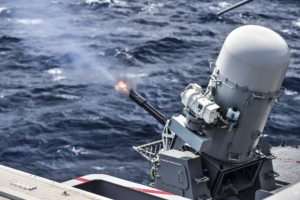
One potential solution has been to modify close-in weapon systems (CIWS), originally developed to offset anti-ship missile threats, to generate a counter-surface threat capability. In addition to upgrading CIWS systems, the requirement to deliver accurate, controlled fire against small surface targets has driven the development of an abundance of remotely operated, stabilized, small-caliber weapon systems.
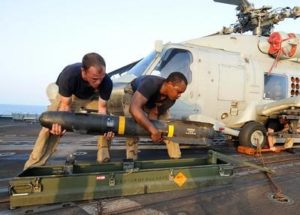
Another proposal to deal with the FIAC swarm threat has been to provide heavier weapons to naval helicopters. U.S. Navy Seahawk helicopters carry the Hellfire missile as well as a variety of crew-served weapons. However, pitting a $40M helicopter and its crew against a cheap FIAC platform armed with IR-guided man-portable air defense systems (MANPAD) that can out-range the helicopter’s weapons is a risky bet the U.S. Navy is unlikely to take.
While some of these efforts appear promising, what makes them less-than-adequate is the fact that Iran has demonstrated the ability to create swarms of dozens of boats which often pop up out of dense shipping traffic with little or no warning. During these exercises, FIAC have attacked from multiple axes and in various attack formations, often spreading out into a wide azimuth sector and closing at speeds of up to thirty-five knots. Such numbers and tactics make conventional weapons systems woefully inadequate to deal with FIAC swarms.
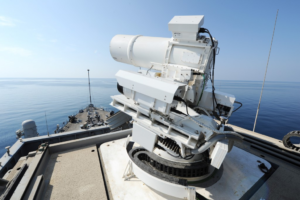
One potential way to address this threat is with directed energy weapons, and the U.S. Navy has attempted to accelerate the development of these technologies. The rapid responsiveness of Directed-Energy Weapons (DEW) makes them potentially useful against the FIAC threat that can effectively out-maneuver the harassing fire of conventional gun systems. The physical characteristics of DEW systems can give the defender more control over the effects generated than any conventional weapon.
While the potential of DEW to deal with FIAC swarms remains promising, development of these weapons has not proceeded as rapidly as many advocates have predicted. And in today’s challenging budget environment, it is unlikely that weapons with long-term development horizons will be able to compete for scarce research and development funding. If none of these current — or future — technologies offer an effective way to deal with FIAC swarms, are western navies doomed to be held hostage this threat?
Seeking a Convergence of Technologies to Defeat Swarming FIAC
In his 2015 article in War on the Rocks entitled “Counter-Swarm: A Guide to Defeating Robotic Swarms,” proclaimed Mad Scientist Paul Scharre, author of Army of None: Autonomous Weapons and the Future of War, explored some of the ways to deal with swarms. One of the suggested methods that had the highest potential to cheaply and effectively take out a swarm was another swarm. He pointed to research at the Naval Postgraduate School that is investigating swarm-on-swarm warfare tactics.
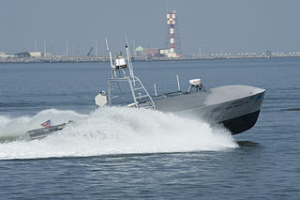
While the current focus of the Naval Postgraduate School’s swarm-on-swarm research involves airborne swarms, these technologies and tactics can easily be adopted for Unmanned Surface Vehicles (USVs). What is needed to explore this tactic is an effective Concept of Operations (CONOPS) and small, low-cost, highly maneuverable USVs. As little as five years ago, that CONOPS and its USVs did not exist. Today they do.
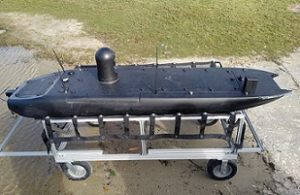
Over the past several years, in a series of U.S. Navy and Marine Corps exercises, experiments, and demonstrations, operators have field-tested a wide range of emerging technologies, many of them unmanned systems. One of the technologies that performed well was the MANTAS USV. During these events, the MANTAS was scaled-up from a six-foot, to eight-foot, to twelve-foot version. In Exercise Valiant Shield, MANTAS was tasked with re-supply missions, carrying cargo to troops ashore. As a result of that mission success, U.S. Navy and Marine Corps officials asked MANTAS’ manufacturer, MARTAC, Inc., to scale-up the MANTAS further and design a thirty-eight foot and fifty foot version.
Concurrently, the U.S. Navy has revealed a commitment to developing large and medium USVs. This decision was noted by Congressional Research Service analyst Ron O’Rourke in his March 30, 2020 report,Navy Large Unmanned Surface and Undersea Vehicles: Background and Issues for Congress, where he identified unmanned vehicles as a capability “that the Navy … is pursuing to meet emerging military challenges.”

In a recent article in U.S. Naval Institute Proceedings, the Navy’s program manager for unmanned maritime vehicles, Captain Peter Small, echoed the tenets of the Congressional Research Service report and addressed the mission sets for these unmanned surface vehicles, noting, “The Navy has accelerated plans to develop medium (MUSV) and large (LUSV) unmanned surface vehicles. The Navy is committed to developing unmanned maritime systems for employment alongside manned combatants. Investment in unmanned technologies continues to grow, balanced carefully with other fleet recapitalization efforts.”
Given the U.S. Navy’s commitment to develop a family of USVs, all that remains is to put the pieces together to develop a CONOPS to employ these emerging technologies to deal with FIAC swarms — not just for future warfare in 2050, but for today.
Building the Counter-Swarm CONOPS
The technologies to enable this CONOPS are coming on line rapidly. The U.S. Navy is committed to building MUSVs (the scaled-up thirty-eight foot and fifty foot MANTAS among the candidates) as well as LUSVs. According to the CRS report, the Navy envisions LUSVs as being 180 feet to 300 feet in length and having a full load displacement of about 2,000 tons.

Such a craft could easily hold several score of the smaller MUSVs such as the 38 foot and 50 foot MANTAS USVs that could then be further outfitted with a number of smaller UUV, USV, and/or even airborne UAVs, thereby providing a fully “unmanned-unmanned” solution to the FIAC threat. While the larger LUSV and MUSV craft can be weaponized with traditional surface-to-surface guns and missiles, the smaller UUV, USV, and UAV can be used as direct-strike devices.
These relatively low-cost, high-speed (in excess of 60 knots), extremely maneuverable vessels (12g turning capability) can be fitted with high-explosives, and using basic autonomous vehicle technology, programmed to perform a suicide mission against a FIAC swarm. The Naval Postgraduate School has already demonstrated the ability to do this in the air; now all that remains is to do so in the maritime mode.

While sending even relatively cheap USVs on a suicide mission may seem like a radical solution, the potential to save a $12 billion aircraft carrier, $4 billion Zumwalt destroyer or $2 billion Arleigh Burke destroyer makes such a solution a compelling alternative. Given the inadequate ability of other weapons to take on FIAC swarms, the U.S. Navy would be well-served to accelerate efforts to test this counter-swarm CONOPS without delay.
If you enjoyed this post, check out these other posts that explore the ramifications of mass via swarms in other domains:
Jomini’s Revenge: Mass Strikes Back! by proclaimed Mad Scientist Zachery Tyson Brown
The PLA: Close Combat in the Information Age and the “Blade of Victory”
A New Age of Terror: The Future of CBRN Terrorism and A New Age of Terror: New Mass Casualty Terrorism Threats, by Zachary Kallenborn
Star Wars 2050, by proclaimed Mad Scientist Marie Murphy
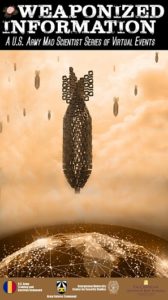 >>> REMINDER 1: The Mad Scientist Initiative will facilitate the next webinar in our Weaponized Information Virtual Events series on Wednesday, 1 July 2020 (1300-1430 EDT):
>>> REMINDER 1: The Mad Scientist Initiative will facilitate the next webinar in our Weaponized Information Virtual Events series on Wednesday, 1 July 2020 (1300-1430 EDT):
Weaponized Information: The Storm After the Flood — This virtual wargame will be facilitated by Dr. Gary Ackerman, The Center for Advanced Red Teaming, University at Albany, SUNY, with crowdsourced participation.
In order to participate in this virtual event, you must first register here [via a non-DoD network]. Registration is limited, so sign up now! And stay tuned to the Mad Scientist Laboratory for more information on our upcoming Weaponized Information virtual events!
>>> REMINDER 2: Mad Scientist wants your Information Warfare Vignettes! We launched this crowdsourcing exercise to complement our Weaponized Information Virtual events and we want to hear from you! Review submission guidelines on our flyer here, then craft and submit your most innovative and insightful visions of information warfare to us at: MADSCITRADOC@gmail.com. The winner of our writing contest will be present at our virtual conference on 21 July 2020. Deadline for submission is 1 July 2020!
>>> REMINDER 3: If you missed the first four webinars in our Mad Scientist Weaponized Information Virtual Events series — no worries! You can watch them again here [via a non-DoD network].
CAPT George Galdorisi, (U.S. Navy–Ret.), is Director for Strategic Assessments and Technical Futures at the Naval Information Warfare Center Pacific. Prior to joining SSC Pacific, he completed a 30-year career as a naval aviator, culminating in fourteen years of consecutive service as executive officer, commanding officer, commodore, and chief of staff. He writes frequently about the future of warfare in both fiction and nonfiction formats, including his two most-recent novels, The Coronado Conspiracy and For Duty and Honor, as well as his forthcoming nonfiction book (from U.S. Naval Institute Press) AI at War. How Big Data, Artificial Intelligence, Machine Learning, and Big Data Are Changing Naval Warfare.
Disclaimer: The views expressed in this blog post are those of the author, and do not necessarily reflect those of the Department of Defense, Department of the Navy, Department of the Army, Army Futures Command (AFC), or Training and Doctrine Command (TRADOC).

